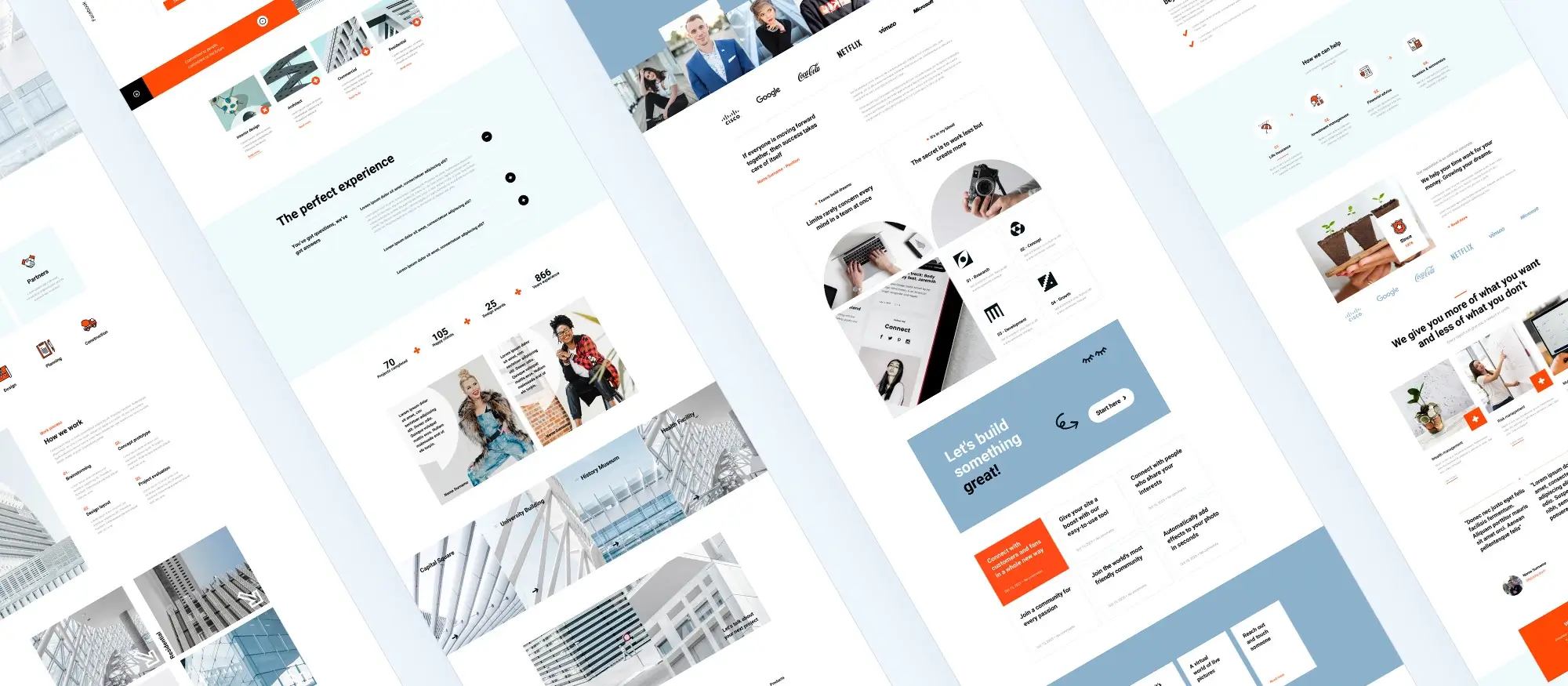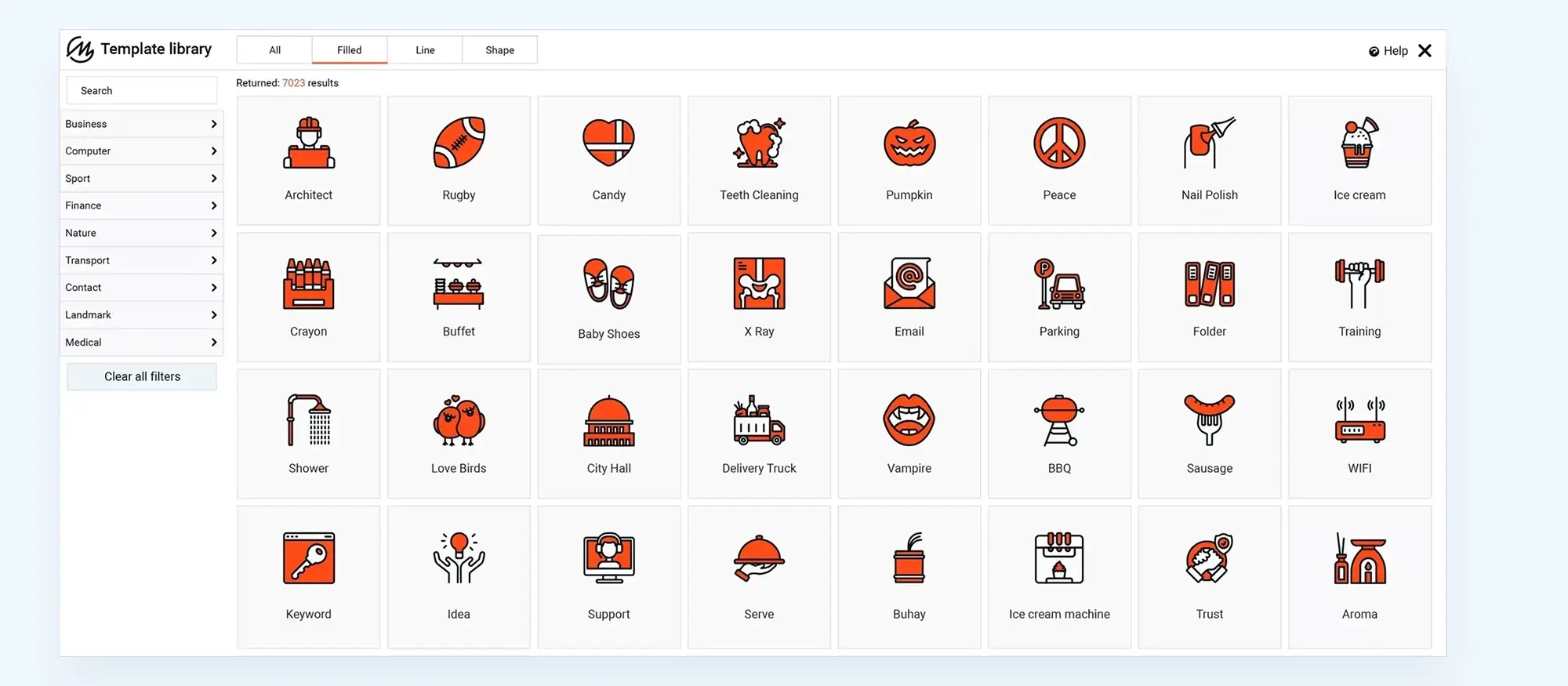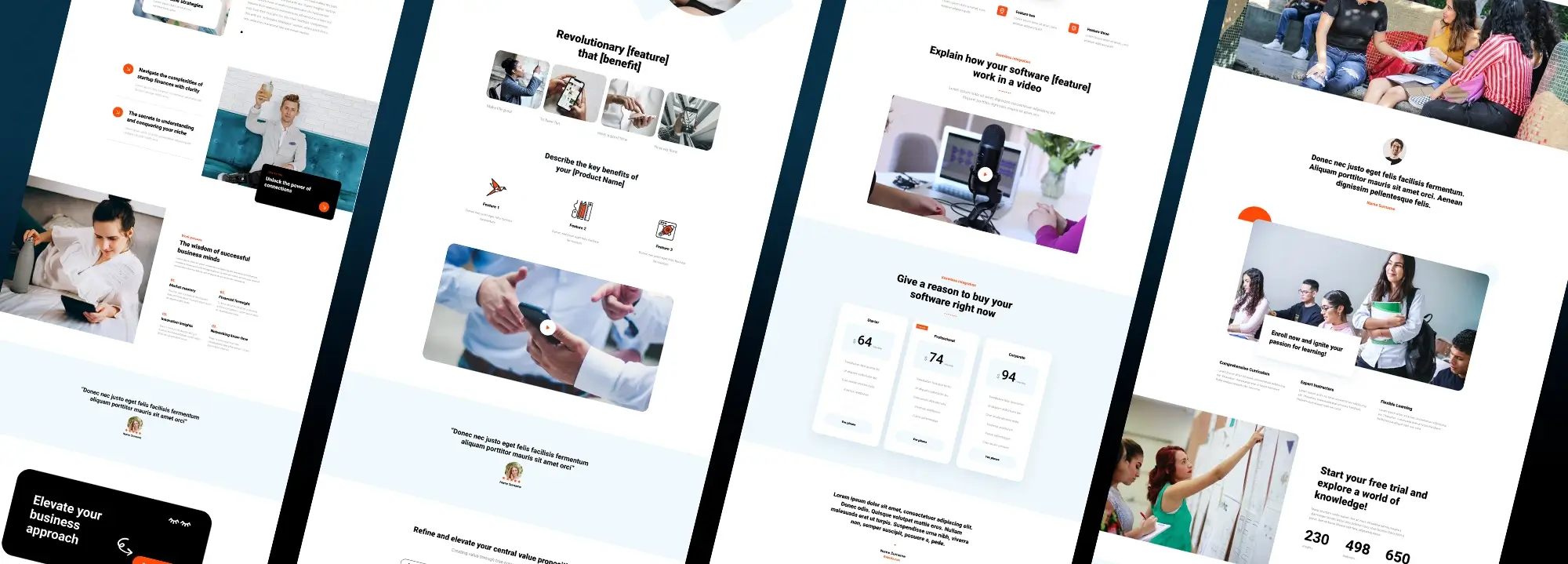Freelance WordPress web designer
Try MaxiBlocks for free with 500+ library assets including basic templates. No account required. Free WordPress page builder, theme and updates included.

Updated 15th May 2025
Freelance WordPress web designer: what you need to know
The demand for freelance web designers has grown rapidly in recent years. More businesses, entrepreneurs, and content creators are prioritising their online presence and that means they need websites that look great and perform well. As the web becomes more competitive, the value of professional design continues to rise.
WordPress is one of the most popular platforms for building websites, and with good reason. It’s flexible, beginner-friendly, and powerful enough to support everything from personal blogs to large e-commerce stores. As of 2024, WordPress powers over 43% of all websites globally, proving just how dominant it is in the content management system (CMS) space.
In the U.S. alone, the web design industry is worth over $40.8 billion, and many freelance WordPress designers earn between $3,000 and $15,000+ per custom website depending on the complexity and scope of the project.
According to the U.S. Bureau of Labor Statistics, employment for web developers and digital designers is expected to grow 13% from 2020 to 2030, which is much faster than the average for other jobs. That means there’s plenty of opportunity for both new and experienced designers to carve out a freelance career.
In this article, we’ll break down what freelance WordPress designers do, the benefits of hiring one, how to become one, and practical tips to succeed in this growing industry. Whether you’re looking to hire or become a freelance designer, this guide will give you a solid head start.

Who is a freelance WordPress web designer?
A freelance WordPress web designer is a self-employed professional who designs and builds websites using the WordPress platform. Unlike in-house designers or those working for agencies, freelancers work independently and take on projects from a variety of clients across different industries.
This role blends creativity with technical skill. Freelance designers need a solid understanding of HTML, CSS, and PHP, as well as experience with WordPress themes, plugins, and page builders. They also need strong communication and project management skills to keep clients informed and projects on track.
In most cases, a freelance WordPress designer handles more than just the visuals. They’re responsible for planning the site structure, designing the layout, implementing features, and often helping with content and SEO basics. Many also offer maintenance, training, or ongoing support.
The job can be demanding but it’s also highly flexible and rewarding. Freelancers get to choose the projects they take on, set their own schedules, and work from anywhere. For many, it’s the ideal mix of creative freedom and career independence.
Subscribe to our newsletter
Why hire a freelance WordPress web designer
Bringing in a freelance WordPress web designer can be a smart, cost-effective move especially for small businesses, startups, and solo entrepreneurs. Compared to hiring an in-house designer or working with a large agency, freelancers often offer more flexibility, personal service, and value for money.
Cost-effective solutions
Hiring a freelancer can significantly reduce your overall spend on website design. In the UK, freelance WordPress designers typically charge between £40 and £70 per hour, depending on their experience and the complexity of the project. For a standard brochure-style website, you might expect to pay around £1,000 which often includes responsive design, basic SEO setup, and training on how to manage the site.
In contrast, a traditional web design agency might charge £3,000 to £6,000 or more for a similar project. Their higher prices usually reflect larger teams, office overheads, and added layers of management not necessarily better results for your site.
Flexibility and personalised attention
One of the biggest benefits of working with a freelancer is flexibility. Freelancers are used to adapting to different timelines, budgets, and project scopes. Whether you need a quick one-page site or a multi-page redesign, a freelancer can usually work around your schedule.
You also get a more personalised service. Instead of going through account managers or project coordinators, you deal directly with the person building your website. This often means faster communication, more attention to detail, and a final result that’s more aligned with your vision.
If you value a hands-on, collaborative approach and want to keep your project on budget, hiring a freelance WordPress designer can be a great choice.

How to become a freelance WordPress web designer
You don’t need a university degree to become a successful freelance WordPress web designer. In fact, many top designers are self-taught, having learned through a mix of online resources, real-world projects, and steady practice. That said, a background in web design, digital media, or computer science can definitely give you a head start.
Learn the basics and build your skills
Start by getting comfortable with the WordPress platform. Learn how themes, plugins, and page builders like MaxiBlocks work together. From there, build your knowledge of essential web design tools and languages HTML, CSS, JavaScript, and PHP. There are plenty of free and paid courses on sites like YouTube, Udemy, and LinkedIn Learning to guide you.
If you’re just starting out, focus on hands-on learning. Create demo websites, experiment with different layouts, and try rebuilding existing sites to test your skills.
Build a strong portfolio
Your portfolio is your most important marketing tool. It shows potential clients what you’re capable of and gives them confidence in your ability. Include at least 3–5 varied projects that highlight your design range, technical skill, and problem-solving ability. Where possible, add short case studies that explain the project goals, your process, and the results.
If you’re still building experience, don’t be afraid to do a few small or volunteer projects to fill out your portfolio just make sure they represent your best work.
Network and find your first clients
Networking is key to building a sustainable freelance business. Start by joining online communities for WordPress professionals on Facebook, Reddit, LinkedIn, or dedicated forums. Follow agencies and potential clients on social media and engage with their content.
Freelance platforms like Upwork, PeoplePerHour, and Toptal are great places to find your first paid gigs. Don’t forget local opportunities, either many small businesses are looking for affordable help with their websites.
Attending WordPress meetups or WordCamps (many of which are free or low-cost) can also help you connect with clients and other freelancers who might refer work your way.
Build like a pro
Qualities, tools, and challenges of freelance WordPress web designers
Succeeding as a freelance WordPress web designer takes more than just technical knowledge. It’s a balance of creative skill, professional discipline, and a commitment to continuous learning. Here’s a breakdown of the qualities, tools, and challenges that shape the role.
Top qualities of a successful freelance WordPress web designer
Technical proficiency
A strong grasp of web development basics HTML, CSS, JavaScript, and PHP is essential. These languages help you customise themes, troubleshoot problems, and build more flexible sites.
Creative design sense
Good design is more than looking pretty. It needs to be functional, accessible, and aligned with the client’s brand. The ability to balance aesthetics with usability sets great designers apart.
Strong communication skills
Freelancers must clearly communicate with clients to understand their goals, set realistic expectations, and provide updates throughout the project. Good communication builds trust and keeps things running smoothly.
Time management
Managing your own schedule means staying organised and hitting deadlines across multiple projects. A reliable workflow helps ensure you deliver quality work without burnout.
Problem solving
Technical hiccups are part of the job. Successful freelancers know how to troubleshoot quickly and adapt to challenges whether it’s a broken plugin or a last-minute client change.
Tools and resources
Freelancers rely on a variety of tools to streamline their work and maintain quality:
- Text editors like VS Code or Sublime Text for writing clean code.
- Design tools like Figma, Sketch, or Adobe XD for mockups and prototypes.
- Version control with Git to manage and track changes in projects.
- Page builders like MaxiBlocks to speed up visual design with drag-and-drop flexibility.
- Project management tools like Trello, ClickUp, or Notion to stay organised.
It’s also important to keep up with industry trends. Subscribe to design and WordPress blogs, take part in online courses, and follow tutorials from creators who specialise in WordPress development.
Common challenges and how to overcome them
Finding clients
Starting out, it can be tough to land regular work. Build a strong portfolio, ask for testimonials, and focus on referrals and networking to grow your client base.
Managing time and workload
Freelancers often juggle several projects at once. Use tools like time trackers, calendars, and to-do lists to keep on top of your work. Plan your week ahead and block out time for focused work.
Client boundaries
Scope creep, unclear briefs, and last-minute changes can lead to frustration. Always use contracts, define clear deliverables, and communicate your availability from the start.
Staying motivated
Working solo can feel isolating. Join online communities, co-working groups, or local meetups to stay connected. Break your goals into smaller tasks and celebrate milestones to stay on track.
Continuous learning
The digital space evolves quickly. Set time aside each week to read blog updates, take micro-courses, or test new plugins and design methods so your skills stay sharp.

Real-life success stories and your next steps
Real-life success stories
There are countless examples of freelance WordPress web designers who have built thriving careers from the ground up.
Take Jane, for instance. After leaving a long-term corporate role, she turned her passion for design into a freelance career. By focusing on small businesses in her area, she quickly developed a reputation for delivering beautiful, functional websites that drove real results. Within a year, she had a steady stream of referrals and was able to triple her previous income while working fewer hours and enjoying more creative freedom.
Then there’s Mark, who found his niche in e-commerce. By specialising in WordPress sites powered by WooCommerce, he positioned himself as a go-to expert for online stores. His deep understanding of user experience and checkout optimisation helped him land high-profile clients and build a sustainable business that supports his lifestyle and long-term goals.
These stories highlight a common theme: focus, consistency, and client satisfaction lead to lasting success in the freelance web design world.
Final thoughts: your next steps
Freelance WordPress web designers play a key role in helping individuals and businesses build their online presence. Whether it’s a simple landing page or a full e-commerce platform, their skill set brings visions to life in a practical, cost-effective way.
If you’re thinking of hiring a freelance WordPress designer, consider the benefits lower costs, direct communication, and more personalised service than most agencies can offer.
And if you’re thinking of becoming one, know that the path is open. Build a strong portfolio, focus on one niche or audience, keep improving your skills, and show up consistently you’ll find your place in the market.
We’d love to hear your thoughts. Have you worked with a freelance WordPress designer? Are you freelancing yourself? Share your stories in the comments or connect with us for advice.
Additional resources
If you’re ready to explore more, check out our favourite WordPress blogs and communities for expert insights, tips, and real-life inspiration. You can also dive into hands-on tutorials and learn to build beautiful sites visually with tools like MaxiBlocks. For those just starting out, the MaxiBlocks Go Theme is a great way to build fast, responsive sites with zero coding needed. With the right tools and support, freelance success is closer than you think.
Why custom web design matters for freelance WordPress developers
As a freelance WordPress web designer, offering custom websites allows you to deliver tailored solutions that truly meet your clients’ goals. While pre-built themes and generic page builders can serve as quick fixes, a custom WordPress website gives you full control over structure, functionality and design. It lets you align every detail with your client’s brand and long-term strategy, helping you stand out in a competitive space.
Whether you’re collaborating with top WordPress designers or building your own reputation as a trusted freelance WordPress web designer, custom development positions you as a problem-solver, not just a builder. To streamline your workflow, equip each project with essential WordPress plugins or explore this expanded plugin guide to improve speed, SEO and user experience.
Building smarter, faster and more scalable sites
Performance is just as important as design. Choosing the right hosting environment ensures your projects are stable and scalable. You can explore the basics of WordPress hosting, review dedicated website hosting or compare hosting options to support different client needs. On the front end, knowing how to use Flexbox effectively will help you build cleaner, more responsive layouts, especially when applying these advanced Flexbox direction tips.
For interface design, this Font Awesome guide shows you how to add scalable icons without bloating your site. And if your clients are looking to improve their search visibility, sharing this beginner’s guide to keyword research is a great way to support content strategy. Offering custom web design as a freelancer not only helps your clients achieve better results but also enhances your credibility as a developer who builds with purpose and precision.
Smart solutions for modern WordPress web designers
Design better sites with smart solutions built for WordPress web designers and creative teams.
FAQs – Freelance WordPress web designer
What is WordPress?
WordPress is a content management system (CMS) that lets you create and manage websites without needing to code everything from scratch. It’s flexible, easy to use, and supports thousands of themes and plugins to help you customise your site.
Why should I hire a freelance WordPress web designer?
Freelance WordPress designers often offer more flexible pricing and personalised attention compared to agencies. They can tailor a site to your exact needs, work to your timeline, and usually have lower overheads making them a great option for small businesses or startups.
What skills are necessary for a freelance WordPress web designer?
A good freelance WordPress designer should know HTML, CSS, and PHP. They should also be familiar with WordPress themes, page builders like MaxiBlocks, and popular plugins. Communication, time management, and the ability to solve design or tech issues are just as important.
How do I become a freelance WordPress web designer?
Start by learning WordPress basics and building a portfolio of real projects even if they’re just for practice. Set up your own website, join freelance platforms, and network online. Keep learning through tutorials, courses, and industry blogs to grow your skills.
What tools do freelance WordPress web designers use?
Common tools include page builders like MaxiBlocks, code editors like VS Code, and design software such as Figma or Adobe XD. Designers also use SEO plugins, backup tools, and staging environments to streamline their workflow.
What are common challenges faced by freelance WordPress web designers?
Freelancers often juggle multiple projects, manage their own schedules, and handle everything from design to client communication. Finding consistent work, setting boundaries, and staying organised are key to long-term success.
WordPress itself
Official Website
wordpress.org – This is the official website for WordPress, where you can download the software, find documentation, and learn more about using it.
WordPress Codex
codex.wordpress.org/Main_Page – This is a comprehensive documentation resource for WordPress, covering everything from installation and configuration to specific functionality and troubleshooting.
WordPress Theme Directory
wordpress.org/themes – The official WordPress theme directory is a great place to find free and premium WordPress themes. You can browse themes by category, feature, and popularity.
maxiblocks.com/go/help-desk
maxiblocks.com/pro-library
www.youtube.com/@maxiblocks
twitter.com/maxiblocks
linkedin.com/company/maxi-blocks
github.com/orgs/maxi-blocks
wordpress.org/plugins/maxi-blocks

Kyra Pieterse
Author
Kyra is the co-founder and creative lead of MaxiBlocks, an open-source page builder for WordPress Gutenberg.
You may also like

